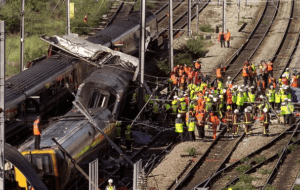On the morning of 5 October 1999, two trains travelling at a combined speed of 130mph collided, causing the death of 31 passengers, at Ladbroke Grove just outside Paddington Station in London.
 To mark the anniversary, 32 candles were lit for each of the passengers that died, and one more for those that survived the crash, followed by a one minute silence.
To mark the anniversary, 32 candles were lit for each of the passengers that died, and one more for those that survived the crash, followed by a one minute silence.
But, have we learned anything from the crash and have safety standards on the railway improved? The incident happened when one of the drivers missed a red signal, hitting the oncoming train head-on, causing a huge fireball. As well as the 31 fatalities, 417 people were injured, partly due to a huge fireball in the aftermath.
According to data from the Office of Rail and Road (ORR), a 10-year record high 304 trains passed through red signals in 2018-19.
Jonathan Duckworth, Chair of the Paddington Survivors Group, told the BBC that he fears that standards may be dropping. The number of Signals Passed at Danger (Spads) during the decade after the crash more than halved, from 593 to 273.
However, the number is on the rise again. In July this year, there were 41 Spads, more than one a day, the highest number in a single calendar month for 12 years. Minor accidents have also increased and three rail workers have been killed by trains in the last year
Mr Duckworth said: “Our crash, and others, happened because they took their eyes off safety. If they do that again more will be killed and more lives devastated.”
Rail Minister Chris Heaton-Harris said that The UK has “one of the safest railway networks in Europe.”
“We are continually learning how to make our railways safer, that is the legacy of a terrible disaster such as this,” he added.
“But disasters could happen any time. That is why one of my many jobs is to ensure we have safety hardwired into every decision that they make.”
Scrutiny
The Ladbroke Grove Rail Inquiry, written by Lord Cullen and published by the Health and Safety Executive, scrutinised Railtrack, the company responsible for maintaining British railway at the time, for numerous safety breeches including:
- Not providing adequate driver training and;
- Questioning the response time of signallers, in Slough control box, in acting quicker to warn drivers of crash.
Five years before the collision, Railtrack was warned that drivers misinterpreted signals at least seven times, but no adequate action was taken by the company, according to Blackfriars Crown Court. Consequently, Railtrack was liable for a “catalogue of failures” that led to the crash.
Phil Chambers BSc, CMIOSH Strategic Safety Systems Ltd, used the Paddington Rail Crash as a case study to the Heinrich’s Triangle to describe how, if you have enough safety breaches, it will eventually lead to serious injury.
Lord Cullen described the safety culture at Thames Trains, one of the franchise firms involved in the crash, as “less than adequate”. It was reported that the crash could have been prevented had there been a train protection in place.
This eBook will guide you through some of the key understandings you need to be able to manage driver safety effectively and, at the end, provide a series of free resources you can access to help you ensure your own driver safety management system is robust, legally compliant and in line with industry-accepted good practice.
Download this eBook from Driving for Better Business and SHP to cover:
- Why do we need to manage driver safety?
- Duty of care – a shared responsibility;
- Setting the rules with a driving for work policy;
- Managing driver safety;
- Ensuring safe vehicles;
- Safe journeys and fitness to drive;
- Record keeping;
- Reporting;
- The business benefits of good practice;
- Additional resources


